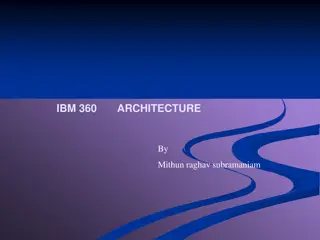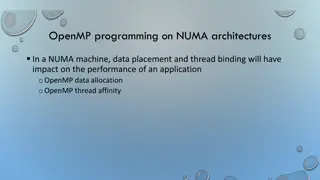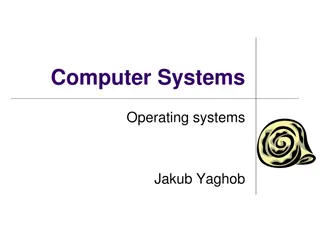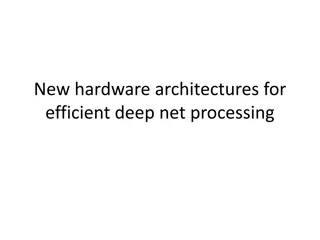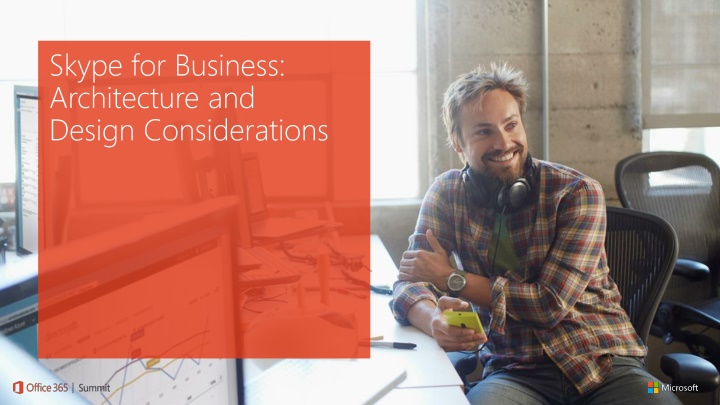
Analyzing Computer Architectures for Performance Optimization
We employ a quantitative approach to analyze computer architectures, focusing on RISC instruction sets for promoting parallelism and optimizing performance. Delve into the evolution of microprocessors and classes of computers to understand the advancements in the field. Explore significant processors like Intel 4004 and Motorola MC68000, tracing their impact on computing history. Discover the progression from 16-bit to 32-bit processors and the introduction of advanced features like pipelining and mathematical coprocessors. Uncover the development of processors like the Intel 8086 and AT&T BELLMAC-32A, paving the way for modern computing systems.
Download Presentation

Please find below an Image/Link to download the presentation.
The content on the website is provided AS IS for your information and personal use only. It may not be sold, licensed, or shared on other websites without obtaining consent from the author. If you encounter any issues during the download, it is possible that the publisher has removed the file from their server.
You are allowed to download the files provided on this website for personal or commercial use, subject to the condition that they are used lawfully. All files are the property of their respective owners.
The content on the website is provided AS IS for your information and personal use only. It may not be sold, licensed, or shared on other websites without obtaining consent from the author.
E N D
Presentation Transcript
Skype for Business: Architecture and Design Considerations
Agenda Skype vs Skype for Business Motivation for this session Planning/deployment cycle Deployment options Architecture recommendations Pool sizing Enhanced manageability approaches
Skype vs Skype for Business The consumer experience that people around the world know and love will continue to be referred to as Skype Skype for Business brings together the familiar experience and user love of Skype with the enterprise security, compliance, and control from Lync End users get a familiar Skype experience that is as easy to use at work as it is at home
Motivation Satisfied customers High quality Skype for Business implementation Meeting customer requirements Support and complexity Fully supported and validated scenarios Complexity needs to be manageable Enable partners to be successful Clear and descriptive guidance Risk management Reduce risk for customers and partners Customer satisfaction Cloud push Partner enablement Risk management
What is a successful deployment? Business requirements Easy to deploy Happy users Well tested Easy to run High usage Future proof Well documented
Skype for Business lifecycle Readiness Business case Strategic plan Use cases Communications transformation User feedback Adopt Plan Operations Change control Call quality Deployment topologies Client strategy Rollout Run Deploy
Deployment options Supported Supported Topologies Topologies Do you feel lucky? Focus of today s session Recommended Recommended Topologies Topologies Structured Structured Topology Topology Reference Architectures O365MT Standardized Standardized Topology Topology
Design decisions The important question: Is it a good idea? NOT: Will it work Goal: predictable outcome Successful project Low risk
Deployment choice Online Server Hybrid
Decision tree Missing features? Missing features? Legal requirements? Legal requirements? Global company? Global company? Prohibitive customer Prohibitive customer infrastructure? infrastructure? Deploy Deploy O365MT O365MT Does O365MT meet Does O365MT meet requirements? requirements? Yes No Some new investments will Some new investments will require hybrid even for require hybrid even for on premises premises customers customers Is Skype for Business hybrid Is Skype for Business hybrid an option? an option? Yes Deploy hybrid Deploy hybrid on No Deploy Deploy on premises premises on Legal requirements? Legal requirements? Prohibitive customer Prohibitive customer infrastructure? infrastructure?
Skype for Business Online Exchange Online Skype for Business Online Directory Synchronization Azure AD Customer User AD O365MT Customer AD
Skype for Business Online All users are in a single user forest There are no resource forests present Also, there is only a single user forest Single O365 tenant Exchange is provided via O365 Skype for Business on premises can be introduced later with hybrid
Skype for Business Hybrid Split Domain Exchange Online Skype for Business Server Skype for Business Online Directory Synchronization Azure AD Customer User AD O365MT Customer AD
Skype for Business Hybrid All users are in a single user forest There are no resource forests present Also, there is only a single user forest Skype for Business on premises is deployed in the user forest Exchange Skype for Business users online consume Exchange via Exchange Online Skype for Business users on premises consume Exchange either online or on premises Important Federation and login via Skype for Business on premises environment
Skype for Business On Premises Skype for Business Server Customer User AD Customer AD
Skype for Business On Premises Skype for Business deployed in user forest Exchange is provided either via Exchange on premises in user forest Exchange Online Exchange Hybrid Skype for Business hybrid can be enabled later
Three-forest architecture Motivation Enable partners to host Lync 2013 for customer Provide full Lync on premises feature set while consuming Lync as a service Consume Exchange from O365MT Documentation Whitepaper published September 2014 Deploying Lync in a Multi-Forest Architecture (Partner Hosted Lync with Exchange Hybrid) http://www.microsoft.com/en-us/download/details.aspx?id=44276 TechEd session Microsoft Lync Deployment Options and the Multi-Forest Architecture http://channel9.msdn.com/Events/TechEd/Europe/2014/OFC-B412
Three-forest Directory Synchronization Azure AD Exchange Server Customer User AD User Forest FIM Exchange Online Lync Server Resource Forest AD O365MT Resource Forest
Three-forest status Supported for Lync 2013 Since September 2014 Very complex Three different forests interacting Trust required between resource and user forest Directory synchronization user forest and resource forest (FIM) Directory synchronization user forest and O365 (DirSync) Only topology that allows combination of Lync in resource forest Exchange in O365 (pure or hybrid) Alternatives Can customer AD be extended to partner datacenter?
Recommendations Skype for Business O365MT Single Tenant in O365MT Single user forest No resource forests Skype for Business Hybrid Single Tenant in O365MT Single user forest No resource forests Skype for Business on premises Single user forest No resource forests
Architecture Recommendations Architecture Recommendations
Pool decision tree Remember that Hybrid Remember that Hybrid leverages on premises leverages on premises servers servers Do you need High Do you need High Availability? Availability? Can Standard Edition Server Can Standard Edition Server support all users? support all users? Do you need Disaster Do you need Disaster Recovery? Recovery? no yes no yes yes no Do you need Disaster Do you need Disaster Recovery? Recovery? Single Standard Single Standard Edition Pool Edition Pool Paired Standard Paired Standard Edition Pools Edition Pools Single Enterprise Single Enterprise Edition Pool Edition Pool no yes Seriously? Seriously? Paired Enterprise Paired Enterprise Edition Pools Edition Pools
Enterprise Edition pool Three Front Ends minimum Two Front Ends supported but not recommended Very specific steps required, if you need to restart your pool or servers Use Hardware Load Balancer for HTTP Never lose two (or more) servers at the same time Consider failure domains when placing servers
Routing groups Each user is part of exactly one routing group Placement during user provisioning Will change when servers are added to pool (or removed) Holds information about this user Presence, Contacts, Groups, Voice Settings, Conferences, Each routing group has three replicas One Primary Two secondary If one replica is lost, pool will recover If two replicas are lost, replica will lose quorum
Upgrade domains What is it? Front End pools are organized in Upgrade Domains Idea: All servers of a single upgrade domain can be offline without impacting availability Routing groups are distributed to accomplish this goal Initial Pool Size Initial Pool Size Number of Upgrade Number of Upgrade Domains Domains 8 8 8 5 Front Front End Placement per Upgrade Domain End Placement per Upgrade Domain 12 9 8 5 First 8 FEs into 4 UD with 2 each, then 4 UD with 1 each First 2 FEs into one UD, then 7 UD with 1 each Each FE placed into its own UD Each FE placed into its own UD
Pool quorum Pool quorum Pool will go offline if less than 50% of Front End servers are available Pool will also go offline if exact 50% are online but SQL database is not Total Number of Front End Server in the Total Number of Front End Server in the pool (defined in Topology) pool (defined in Topology) 2 3-4 5-6 7 8-9 10-12 Number of Servers that must be Number of Servers that must be running for pool to be functional for pool to be functional 1 Any 2 Any 3 Any 4 Any 4 of the first 7 servers Any 5 of the first 9 servers running
Fault domains A fault domain is a set of hardware components computers, switches, and more that share a single point of failure. IEEE Computer Magazine March 2011 Issue Never lose two* Front End Servers at the same time! *Except if they are part of the same upgrade domain You cannot configure your upgrade domains Use an n+1 model when planning your pools
Metropolitan and Lync 2013/Skype for Business Not supported and will not provide HA Pool quorum is not the main issue Routing groups will be negatively impacted will be negatively impacted As soon as one datacenter is unavailable, users will be impacted Instead of higher availability, it will be lower Solution Don t do Metropolitan! Use paired pools
Front End: Disaster Recovery Use paired pools GeoDNS Get sure that simple URLs and lyncdiscover still work
Disaster Recovery: Too close? What disaster to protect against?
Front End: Too far? What is the latency? Remember: ITU recommends 150ms mouth-to-ear Consider conferencing scenarios What is your bandwidth? What are your SLAs?
SQL back end database Same location as FE servers High Availability SQL mirroring One mirror server Use SQL witness Feature Not Supported in a a Future Version of SQL Server SQL AlwaysOn Runs on top of Windows Server Failover Clustering Up to three Secondary Replicas SQL Enterprise required for more than one replica Disaster Recovery Via pool failover
File Share Used for meeting content, address book files Same location as FE servers High Availability Distributed File Share (DFS) Disaster Recovery Via pool failover
Office Web App Server Used for Presenting PowerPoint Same location as Front End pool High Availability Pool of OWAS Hardware Load Balancer recommended Disaster Recovery Via pool failover
Monitoring Server Database Used for Collection Quality of Experience and CDR data Runs SQL Server Reporting Services and the Server Monitoring Reports Globally one Monitoring database Complete view on your data For performance you might want to copy data to a second database and run reports against the second High Availability Via SQL
Edge Server In Hybrid, on premises environment required for In Hybrid, on premises environment required for sign sign- -in! High Availability is crucial in! High Availability is crucial Used for Remote Access, Federation, O365 Integration Same location as Front End pool High Availability Pool of Edge Servers DNS Load Balancing recommended Disaster Recovery Via pool failover Hardware Load Hardware Load Balancing Federation with OCS 2007, OCS 2007 R2 Federation with OCS 2007, OCS 2007 R2 Exchange UM 2007 or Exchange UM 2010 Exchange UM 2007 or Exchange UM 2010 Legacy clients Legacy clients Balancing recommended if recommended if
Reverse Proxy Used for Meeting join, mobile clients, file download Same location as Edge Server Qualified Reverse Proxies to be published on TechNet High Availability Depends on Reverse Proxy solution Disaster Recovery Via pool failover
Mediation Server Connection to PSTN next hop Placement depends With media bypass can be in datacenter Without media bypass: next to PSTN next hop High availability Pool of mediation servers Disaster Recovery Multiple pools, multiple voice routes What about incoming What about incoming calls? calls?
Mediation Server: co-location Depends on the load on Mediation Server Calls with Media Bypass put very little load on Mediation Server Some type of calls will never leverage media bypass Calls to/from external users via Edge Conference dial-in/dial-out Calls controlled by Call Admission Control Dual homed mediation Needs to be dedicated Mediation Server
SBA, SBS Survivable Branch Appliance/Server Place next to PSTN next hop Qualified devices to be published on TechNet High availability Multiple gateways User services provided by Front End Pool Disaster recovery SBA/SBS users will have only limited functionality mode in pool failover Trade Trade- -off: survivability vs off: survivability vs disaster recovery disaster recovery
Call Quality Dashboard (CQD) Your next generation call quality reports!
Call Quality Dashboard Components Archive Database Quality of Experience (QoE) data is replicated and stored QoE Cube Archive DB is aggregated for optimized and fast access Reporting Web Portal Query and visualize QoE data Recommendation Sizing to be determined Requires SQL Enterprise or Business Intelligence
Video Interoperability Server (VIS) Used for Integration in VTC and video gateways Place next to video next hop Qualified devices to be published on TechNet High availability VIS pool Skype for Business facing: DNS LB Video next hop facing: multiple trunks, DNS LB Disaster Recovery Does your video next hop still exist? Trunks to multiple pools Will connect to failover Front End pool
Pool Sizing Pool Sizing
The waterfall Collect requirements Calculate server sizing Deploy servers Live happily ever after
Sizing numbers Supported users per server This is based on recommended hardware This is based on a very specific user model Useful as a starting point Need to be closely monitored and adopted
Healthy planning cycle Based on user model Based on user model Size servers Size servers Key Health Indicators Key Health Indicators Stress and Load test Stress and Load test Monitor Monitor Server health Server health Deploy Deploy Start with pilot users Start with pilot users Enable users Enable users
Examples from user model User models in Lync Server 2013 http://technet.microsoft.com/en-us/library/gg398811.aspx Category Category Peer-to-peer IM sessions Description Description Each user averages six peer-to-peer IM sessions per day. 10 instant messages per session. 5% of users will be in conferences during working hours. Meeting concurrency Media mix for conferences 75% of conferences are web conferences, which include audio plus some other collaboration modalities. 50% add application sharing. We assume one users sends data at a peak of 1.1 MB per second. 50% add instant messaging (with an average of 2 messages per user). 20% add data collaboration, including PowerPoint or whiteboard In these, an average of 2 PowerPoint files presented per conference, with an average PowerPoint file size of 10 MB (without embedded video) or 30 MB (with embedded video). Average of 20 annotations per whiteboard. 20% add video. Of these users, 70% are in conferences enabled for multiview video, where each user receives 2-3 video streams. 15% add shared notes
Server sizing Server Server Front End Server Edge Server Mediation Server Standard Edition Server Lync 2013 Lync 2013 6,600 12,000 1500 concurrent calls 5000 Skype Skype for Business for Business

